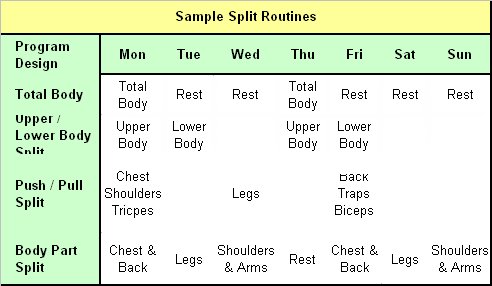Timing – is everything. Whether you are sold on heavy weight and low reps, or less weight and more reps, if your training frequency is not planned with the same scrutiny as other aspects of your routine, you may be wasting time unnecessarily. With a little insight into the factors affecting the optimal timing of your workouts, you may just experience more success than you believed you could.
Knowing exactly when your muscles need to be trained again after the previous workout is difficult to judge with absolute certainty. Recent research in the area of muscle damage and recovery is showing results that may surprise you. Science is now showing us things that may change the way you train forever!
When you lift weights, you cause damage to your muscles. This is often referred to as “microtrauma”. Microtrauma involves the tearing and shearing of delicate protein structures within your muscle cells. This may sound bad but in reality it is necessary for the initiation of growth after your workout.
Microtrauma, as expected, requires a delay before the next training at the time when the muscles back to normal. That is the logic of using “srednestaistichesky ‘coach when he tells you to relax, sometimes even a whole week before a new study of the same body part. But new research shows us that the delay before the next workout until the muscles “fully recovered” is not desirable!
The results showed that muscle mass increases were greater in the three workout per week group, compared to the one workout per week group. In addition, the strength increases in this group were on average 40% greater! So what does this mean to you? It means the fear of overtraining, which sometimes verges on paranoia, may be preventing you from getting the most gains you can in the gym.
So science is telling us that training a muscle group approximately every 48 hours may be more effective than training it once or twice per week. If you train your whole body three times per week with your current workout routine it might take several hours to complete. I doubt many of us would have time for that. Does this mean you can’t reap the benefits of more frequent training? Once again, new research provides us with some answers.
In a study performed at Montclair State University5 researchers investigated the effect of a single set vs. a multiple set routine on increasing upper body strength. They had the subjects perform either one set or three sets of bench press, incline dumbbell press and flat dumbbell flies using ten reps, three times per week for 12 weeks. This kind of study has been done before but this one is particularly valuable because it involved previously “trained” subjects. This is significant because untrained subjects will usually respond positively to virtually any training routine.
Just because a training strategy works for beginners doesn’t mean it will work for experienced lifters. These researchers found that doing a single set of each exercise was equally effective as doing three sets of the same movements in increasing the subjects one repetition maximum (1RM) on bench press.
The take home message is that you needn’t do more than a single work set to achieve the same relative gains of doing multiple sets. This makes incorporating a whole body workout into your schedule much more feasible.
A sample whole body workout might look like this:
10-15 minute warmup on bike or treadmill
Squats, 1-2 warm up sets and 1 work set of 6-8 reps
Leg curls, 1 work set of 6-8 reps
Bench press, 1 warm up and 1 work set of 6-8 reps
Chins or pull ups, 1 work set 6-8 reps. (Add weight as necessary)
Dips, 1 work set of 6-8 reps. (Add weight as necessary)
Seated rows, 1 work set of 6-8 reps
Lying tricep extensions, 1 work set of 6-8 reps
Preacher curls, 1 work set of 6-8 reps
You will notice that this type of training relies heavily on compound exercises. This is necessary to keep the number of exercises down. Don’t worry about this however; compound exercises should be the foundation of any muscle/strength building program.



Post your comment